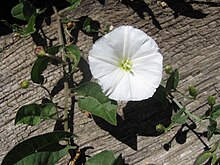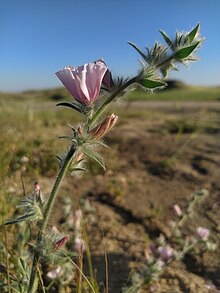Convolvulus
| Convolvulus | |
|---|---|

| |
| Convolvulus arvensis | |
| Scientific classification | |
| Kingdom: | Plantae |
| Clade: | Tracheophytes |
| Clade: | Angiosperms |
| Clade: | Eudicots |
| Clade: | Asterids |
| Order: | Solanales |
| Family: | Convolvulaceae |
| Tribe: | Convolvuleae |
| Genus: | Convolvulus L. |
| Type species | |
| Convolvulus arvensis L.
| |
| Species | |

Convolvulus /kənˈvɒlvjuːləs/ is a genus of about 200 to 250 species of flowering plants in the bindweed family Convolvulaceae, with a cosmopolitan distribution. Common names include bindweed and morning glory; both are names shared with other closely related genera.
Description
They are annual or perennial herbaceous vines, bines and (a few species of) woody shrubs, growing to 0.3–3 m tall. The leaves are spirally arranged, and the flowers trumpet-shaped, mostly white or pink, but blue, violet, purple, or yellow in some species.[citation needed]
Ecology
Many of the species are invasive weeds; but others are cultivated for their attractive flowers, while some are globally threatened.[citation needed]
Convolvulus species are used as food plants by the larvae of some Lepidoptera species, including the convolvulus hawk moth, the sweet potato leaf miner (Bedellia somnulentella) and the gem; the leaf miner Bucculatrix cantabricella feeds exclusively on C. cantabricus.[citation needed]
Gallery
-
Cultivated C. tricolor
-
Seed under a microscope
-
Convolvulus Cephalopodus in Behbahan
-
Convolvulus Cephalopodus
-
Convolvulus Cephalopodus in Behbahan
See also
References
- ^ Sunset Western Garden Book. 1995. 606–07.
- ^ Carine, M. A. and L. Robba. (2010). Taxonomy and evolution of the Convolvulus sabatius complex (Convolvulaceae). Phytotaxa 14 1.
- ^ Convolvulus. Flora of China.
- ^ Convolvulus. The Jepson eFlora. 2013.
- ^ Parnell, J. and Curtis, T. 2012. Webb's An Irish Flora. Cork University Press. ISBN 978-185918-4783
External links
- Beach, Chandler B., ed. (1914). . . Chicago: F. E. Compton and Co.
- Flora Europaea: Convolvulus







